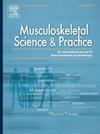Education, rapport and convenience are key to participants’ perceptions of receiving physiotherapy or shockwave for proximal hamstring tendinopathy: a qualitative study
IF 2.2
3区 医学
Q1 REHABILITATION
引用次数: 0
Abstract
Background
Proximal hamstring tendinopathy (PHT) is a challenging musculoskeletal condition commonly affecting active populations, presenting as localised lower buttock pain. While various treatments have been investigated, including physiotherapy and extracorporeal shockwave therapy (ESWT), there is limited understanding of patient experiences with these interventions.
Aim
This study aimed to explore patient perspectives and experiences of receiving physiotherapy and ESWT treatments for PHT to provide insights into their perceived effectiveness and acceptability.
Methods
A qualitative design with semi-structured interviews and an interpretive description approach was applied. Participants were recruited from a randomised trial comparing individualised physiotherapy versus ESWT for PHT. Twenty-two participants (16 women, mean age 46 years), were interviewed after completing their allocated interventions. Data were analysed using thematic analysis to identify patterns and themes.
Results
Participants reported improvements in symptoms and function with both interventions, attributed to education and strong rapport with physiotherapists. Differences between treatment groups emerged in their perceptions of ease of adherence and additional benefits. The physiotherapy intervention group participants reported that exercises were challenging to adhere to but perceived unique functional and strength improvements. Shockwave therapy group participants felt it was easier to comply with, offering pain relief and functional gains but lacked the physical conditioning benefits of physiotherapy.
Conclusion
Both physiotherapy and ESWT were perceived as beneficial for PHT management, with important differences related to ease of treatment adherence and other benefits. These findings emphasise the importance of individualised care and consultation with the patient when choosing treatment for PHT.
教育,关系和便利是关键参与者接受物理治疗或冲击波近端腘绳肌腱病的看法:一项定性研究。
背景:近端腿筋肌腱病(PHT)是一种具有挑战性的肌肉骨骼疾病,通常影响运动人群,表现为局部下臀部疼痛。虽然已经研究了各种治疗方法,包括物理治疗和体外冲击波治疗(ESWT),但对这些干预措施的患者体验的了解有限。目的:本研究旨在探讨PHT患者接受物理治疗和ESWT治疗的观点和经验,以了解其感知有效性和可接受性。方法:采用半结构化访谈的定性设计和解释性描述法。参与者是从一项比较个体化物理治疗与ESWT治疗PHT的随机试验中招募的。22名参与者(16名女性,平均年龄46岁)在完成分配的干预措施后接受了采访。使用专题分析来分析数据,以确定模式和主题。结果:参与者报告了两种干预措施的症状和功能的改善,这归功于教育和与物理治疗师的良好关系。治疗组之间的差异体现在他们对依从性和额外益处的看法上。物理治疗干预组的参与者报告说,锻炼是具有挑战性的坚持,但感知到独特的功能和力量的改善。冲击波治疗组的参与者感觉更容易遵守,提供疼痛缓解和功能增益,但缺乏物理治疗的身体调节益处。结论:物理治疗和ESWT都被认为对PHT治疗有益,在治疗依从性和其他益处方面存在重要差异。这些发现强调了在选择PHT治疗方法时个性化护理和咨询患者的重要性。
本文章由计算机程序翻译,如有差异,请以英文原文为准。
求助全文
约1分钟内获得全文
求助全文
来源期刊

Musculoskeletal Science and Practice
Health Professions-Physical Therapy, Sports Therapy and Rehabilitation
CiteScore
4.10
自引率
8.70%
发文量
152
审稿时长
48 days
期刊介绍:
Musculoskeletal Science & Practice, international journal of musculoskeletal physiotherapy, is a peer-reviewed international journal (previously Manual Therapy), publishing high quality original research, review and Masterclass articles that contribute to improving the clinical understanding of appropriate care processes for musculoskeletal disorders. The journal publishes articles that influence or add to the body of evidence on diagnostic and therapeutic processes, patient centered care, guidelines for musculoskeletal therapeutics and theoretical models that support developments in assessment, diagnosis, clinical reasoning and interventions.
 求助内容:
求助内容: 应助结果提醒方式:
应助结果提醒方式:


